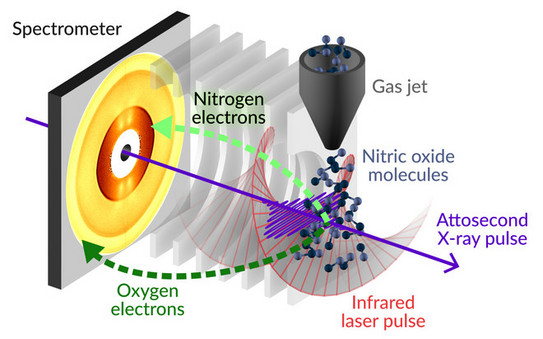Quantum Mechanical Electron Oscillations Observed in Molecules
- News
- Research

Junior Professor Wolfram Helml from the Department of Physics at TU Dortmund University, together with an international research team, has made new observations in the field of photochemistry of molecular quantum systems. Using a kind of stopwatch for ultrafast electron processes in atoms, they have succeeded in observing and controlling coherent superpositions of nuclear excited states in molecules. Scientists from research institutes in the USA, Germany, Switzerland and Great Britain were involved. The results were recently published in the renowned journal "Science".
Electrons can be in a superposition state in which they interfere with each other quantum mechanically, amplifying or cancelling each other out in a quasi-tuned manner. The observation of this phenomenon must - since electron states move extremely fast - take place in the range of attoseconds, an unimaginably short period of time: An attosecond is 10-18 seconds short, which is as much shorter than a second as a second is shorter than the entire age of the universe.
To observe such ultrafast processes, the team used a kind of "stopwatch" that JProf. Helml helped develop. In doing so, they observed the Auger-Meitner effect, an excitation process that occurs in all lighter elements and thus also in organic molecules. In the experiment, the research team directed X-rays at the gas nitrogen monoxide. An electron in a shell close to the nucleus is thereby lifted into a high-energy state and remains just bound to the atom - there are different variants of this intermediate state, which the X-ray beam can trigger all at the same time in the molecule. These are the nuclear excited states of the molecule. "So that no damage occurs, for example the molecule decays into its components nitrogen and oxygen, it wants to 'react off' again quickly," explains JProf Helml. To do this, another electron fills the gap created and is pulled closer to the nucleus. This releases additional energy, which is absorbed by a third electron and leaves the atom - this electron is called an "Auger electron".
Signs of a coherent energy state
Using the "stopwatch", the physicists were now able to measure how many Auger electrons are emitted at what time and at what angle, and what energy they possess in the process (see graph). This produces an exponential curve in which very many electrons are emitted at the beginning and fewer and fewer over time. In the experiment, the research team was able to make this measurement in nitrogen monoxide for the first time. During the evaluation, the researchers also made an unusual discovery: at a point in time when the number of emitted electrons was supposed to decrease, it increased again for a few attoseconds; the curve thus showed an intermediate increase. When the photon energy of the X-ray pulse changed, the researchers were able to measure a modulation of the increase, which is a sign of a coherent energy state.

"By tuning the photon energy, we can deliberately strengthen or weaken the coherence. This allows us to control the decay of the excited state in time," explains JProf Helml. "The time-resolved energies of the emitted Auger electrons are also very sensitive probes for short-lived transition states of the molecule and can reveal a lot about its fundamental properties."
Collaboration with Stanford University
The measurements took place under the leadership of Stanford scientists Siqi Li, Taran Driver and James P. Cryan at the SLAC National Accelerator Laboratory in the US. This is one of only five X-ray lasers in the world that cover the required high-energy range. The observations of the researchers could make it possible in the future to produce such superposition states in a targeted manner and to investigate them more precisely. This could, for example, allow conclusions to be drawn about the exact processes involved in damaging biological samples such as proteins or DNA, or also enable the targeted control of binding sites in molecules.
To the person
Wolfram Helml has been a junior professor at the Centre for Synchrotron Radiation (DELTA) in the Accelerator and X-ray Physics department of the Department of Physics since August 2018. He comes from Linz on the Danube in Austria. Helml studied physics at the Rudolphina in Vienna and graduated there with a thesis in the field of theoretical particle physics. For his dissertation, he switched to the experimental subject at the Max Planck Institute of Quantum Optics in Garching near Munich, where he completed his doctorate with distinction in 2012. With a Marie Curie Fellowship from the European Union, Helml then went to the Stanford Linear Accelerator in California, USA, for just under two years and then did research at the Technical University of Munich. Most recently, he headed the Laser-driven Undulator X-ray source sub-project at the Centre for Advanced Laser Applications at Ludwig-Maximilians-Universität Munich.











